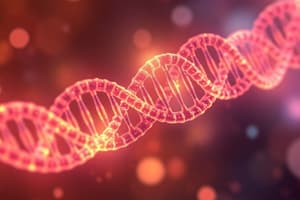Podcast
Questions and Answers
What was the primary research focus of Frederick Sanger after winning his first Nobel Prize in Chemistry?
What was the primary research focus of Frederick Sanger after winning his first Nobel Prize in Chemistry?
- Studying the effects of radioactive isotopes on cells
- Investigating the genetic structure of nucleic acids (correct)
- Researching protein structures
- Developing new synthetic drugs for cancer treatment
Which of the following statements best describes Sanger's method of DNA sequencing?
Which of the following statements best describes Sanger's method of DNA sequencing?
- It involved the use of radioactive isotopes to label DNA fragments. (correct)
- It required the sequencing of amino acids prior to DNA analysis.
- It relied solely on the observation of the physical structure of DNA.
- It was a simple procedure involving only basic chemical reactions.
What was a significant milestone achieved by Sanger in 1977?
What was a significant milestone achieved by Sanger in 1977?
- He mapped the RNA from human cells.
- He discovered the double-helix structure of DNA.
- He invented the first synthetic insulin.
- He fully mapped the DNA of E. coli. (correct)
What challenge did Sanger face when shifting his focus to DNA in the early 1970s?
What challenge did Sanger face when shifting his focus to DNA in the early 1970s?
What was one of Frederick Sanger's notable accomplishments related to insulin?
What was one of Frederick Sanger's notable accomplishments related to insulin?
What was a major outcome of the Sanger sequencing method?
What was a major outcome of the Sanger sequencing method?
Which organism's genome did John Sulston famously sequence in 1988?
Which organism's genome did John Sulston famously sequence in 1988?
What was the primary focus of John Sulston's research that earned him the Nobel Prize?
What was the primary focus of John Sulston's research that earned him the Nobel Prize?
Which aspect of Caenorhabditis elegans made it an ideal subject for biological research?
Which aspect of Caenorhabditis elegans made it an ideal subject for biological research?
What significant achievement did Sanger accomplish related to the human genome in 1981?
What significant achievement did Sanger accomplish related to the human genome in 1981?
Flashcards are hidden until you start studying
Study Notes
Frederick Sanger
- Frederick Sanger was the first person to sequence a protein, which led to the development of synthetic insulin.
- Sanger won his first Nobel Prize in Chemistry in 1958 for his work on protein sequencing.
- He later focused on sequencing DNA, a more complex molecule than RNA.
Sanger's DNA Sequencing Method
- Sanger developed a method using radioactive isotopes to label DNA fragments, allowing him to build up the DNA sequence by identifying areas of overlap.
- By 1967, Sanger had mapped the RNA of E. coli bacteria.
- In 1977, Sanger made a breakthrough by using dideoxy chain-termination, a molecular inhibitor to identify DNA fragments.
- He then shifted his focus to the larger and more complex DNA molecule.
Sanger's Accomplishments
- Sanger sequenced 48,502 base pairs of DNA by 1982.
- His sequencing method, known as the Sanger method, allowed researchers to order DNA strands from shortest to longest.
- This enabled the first human genome to be mapped in 1981, which included the DNA of mitochondrial cells.
John Sulston
- John Sulston, an English biologist, was the first director of the Wellcome Sanger Institute.
- He shared the 2002 Nobel Prize for his work on programmed cell death.
- Sulston's research on Caenorhabditis elegans (a nematode worm) was crucial.
- He sequenced the entire genome of this worm in 1988.
- Sulston's work was significant to the Human Genome Project (1990-2003).
Studying That Suits You
Use AI to generate personalized quizzes and flashcards to suit your learning preferences.



